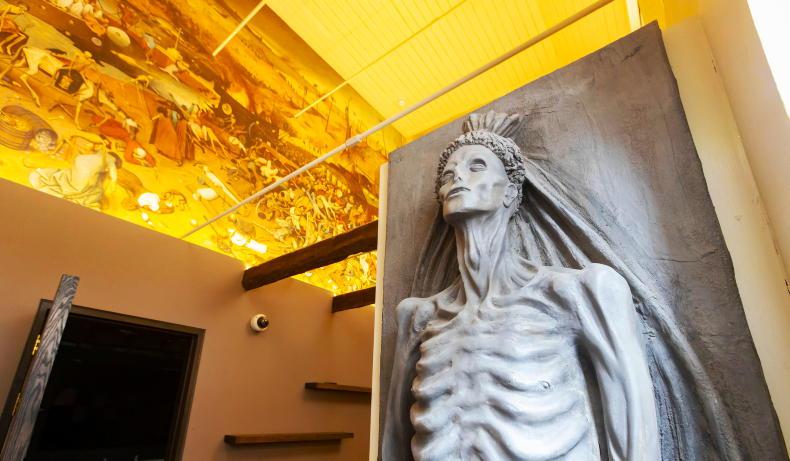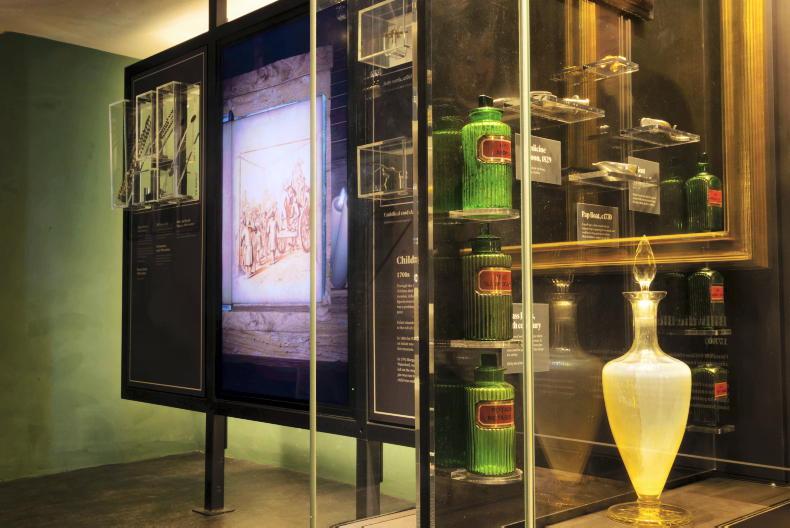It’s commonly known that Irish people ‘do death well,’ but what is it about Ireland’s deep-rooted history that caused this statement to be made in the first place?
Nestled in Cathedral Square in Waterford lies a 15th century reconstructed alms house which deals solely with the topic of death: the Irish Wake Museum.
Entering the building, it is a time capsule of Ireland’s customary traditions; capturing the Irish wake in an informative and immersive way and offering a unique visitor experience.

Irish Wake Museum Waterford, Ireland.
Doorway through history
The museum tour begins with a short video about traditional Catholic practices – including the belief in purgatory – with objects displayed under light, like medieval floor tiles from Waterford Cathedral.
Visitors are then given a presentation about changes in death practices as a result of the 16th century Reformation before learning about old medical practises.
The traditional Irish wake of the 19th century featuring an imitation corpse with coins over its eyes holding a set of rosary beads certainly sets a spooky tone. And then at the end of the tour, there is an opportunity to reflect and write notes about life’s meaning and stick them on a wall.
Rosemary Ryan, acting curator manger at Waterford Treasures (the Waterford Museum Quarters), explains the origins and history of the Irish wake.
“The Irish wake really is such an integral part of Irish culture, and we want to showcase Ireland’s rich history around death,” she says. “As to the origins of the wake, in all our research we never actually found a definitive answer to the development of the phrase.”
Taking an educated guess, Rosemary thinks wakes began to ensure the dead were actually deceased before burial due to anxieties surrounding being buried alive.
“Dating back to the 17th century in Waterford, for example, we have a very interesting copy of a will that outlines a woman’s wishes for her body after death. It includes a month-long wake and eventual decapitation just to avoid being buried alive,” says Rosemary.
All of this said, Ireland’s unique traditions marking death have their roots in ancient Samhain rituals. Samhain falls on the evening before 1 November, marking the beginning of winter. The festival had a strong focus on the spirit world and links with the dead and is the origin of modern-day Halloween.
A timeline of traditions
“Various traditions around wakes have changed throughout the centuries but the sense of community has stayed the same,” says Rosemary. “Clocks were stopped at the time of death, mirrors were covered, and all of the curtains in the house were drawn bar the window closest to the corpse.
“Other customs included hiring female ‘keeners’ to wail and recite poetry as well as leaving tobacco clay pipes and snuff in the room.”
When asked about the building’s history, Rosemary explains: “The building started its life in 1478 as an alms house for a group of mourners who paid their keep by praying three times a night for the souls of its patrons and the deceased citizens of Waterford.
“The building was peeled back to reveal stories by a conservation mason under the supervision of an archaeologist and Waterford City County Council. We even had a timber conservator to conserve the timber beams.”
Once planning and the restoration was completed, the museum was opened in June of this year by Minister for Housing, Local Government and Heritage, Daragh O’Brien.

Irish Wake Museum Waterford, Ireland.
Speaking about the museum’s footfall, Rosemary tells Irish Country Living, “Our busy season runs from March to October. The Wake Museum is Waterford Treasures’ sixth attraction in the Viking Triangle; we had over 103,000 visitors last year.
“The museums are a gorgeous experience for visitors and locals as it has become an area of urban regeneration.”
Waterford’s Viking Triangle
Waterford’s Viking Triangle is known as the cultural and historic centre of Waterford and is situated in the ‘old town’, where the vikings first settled in 914 AD.
Included in the triangle is the House of Waterford Crystal, Bishops Palace, Christchurch Cathedral, the Irish Silver Museum, Reginald’s Tower, Theatre Royale, the Irish Museum of Time and the Irish Wake Museum.
Tickets and information about the Irish Wake Museum and other museums in the Viking Triangle can be found at waterfordtreasures.com
Read more
Meet The Maker: Illustrator Kathryn Leonard
It’s commonly known that Irish people ‘do death well,’ but what is it about Ireland’s deep-rooted history that caused this statement to be made in the first place?
Nestled in Cathedral Square in Waterford lies a 15th century reconstructed alms house which deals solely with the topic of death: the Irish Wake Museum.
Entering the building, it is a time capsule of Ireland’s customary traditions; capturing the Irish wake in an informative and immersive way and offering a unique visitor experience.

Irish Wake Museum Waterford, Ireland.
Doorway through history
The museum tour begins with a short video about traditional Catholic practices – including the belief in purgatory – with objects displayed under light, like medieval floor tiles from Waterford Cathedral.
Visitors are then given a presentation about changes in death practices as a result of the 16th century Reformation before learning about old medical practises.
The traditional Irish wake of the 19th century featuring an imitation corpse with coins over its eyes holding a set of rosary beads certainly sets a spooky tone. And then at the end of the tour, there is an opportunity to reflect and write notes about life’s meaning and stick them on a wall.
Rosemary Ryan, acting curator manger at Waterford Treasures (the Waterford Museum Quarters), explains the origins and history of the Irish wake.
“The Irish wake really is such an integral part of Irish culture, and we want to showcase Ireland’s rich history around death,” she says. “As to the origins of the wake, in all our research we never actually found a definitive answer to the development of the phrase.”
Taking an educated guess, Rosemary thinks wakes began to ensure the dead were actually deceased before burial due to anxieties surrounding being buried alive.
“Dating back to the 17th century in Waterford, for example, we have a very interesting copy of a will that outlines a woman’s wishes for her body after death. It includes a month-long wake and eventual decapitation just to avoid being buried alive,” says Rosemary.
All of this said, Ireland’s unique traditions marking death have their roots in ancient Samhain rituals. Samhain falls on the evening before 1 November, marking the beginning of winter. The festival had a strong focus on the spirit world and links with the dead and is the origin of modern-day Halloween.
A timeline of traditions
“Various traditions around wakes have changed throughout the centuries but the sense of community has stayed the same,” says Rosemary. “Clocks were stopped at the time of death, mirrors were covered, and all of the curtains in the house were drawn bar the window closest to the corpse.
“Other customs included hiring female ‘keeners’ to wail and recite poetry as well as leaving tobacco clay pipes and snuff in the room.”
When asked about the building’s history, Rosemary explains: “The building started its life in 1478 as an alms house for a group of mourners who paid their keep by praying three times a night for the souls of its patrons and the deceased citizens of Waterford.
“The building was peeled back to reveal stories by a conservation mason under the supervision of an archaeologist and Waterford City County Council. We even had a timber conservator to conserve the timber beams.”
Once planning and the restoration was completed, the museum was opened in June of this year by Minister for Housing, Local Government and Heritage, Daragh O’Brien.

Irish Wake Museum Waterford, Ireland.
Speaking about the museum’s footfall, Rosemary tells Irish Country Living, “Our busy season runs from March to October. The Wake Museum is Waterford Treasures’ sixth attraction in the Viking Triangle; we had over 103,000 visitors last year.
“The museums are a gorgeous experience for visitors and locals as it has become an area of urban regeneration.”
Waterford’s Viking Triangle
Waterford’s Viking Triangle is known as the cultural and historic centre of Waterford and is situated in the ‘old town’, where the vikings first settled in 914 AD.
Included in the triangle is the House of Waterford Crystal, Bishops Palace, Christchurch Cathedral, the Irish Silver Museum, Reginald’s Tower, Theatre Royale, the Irish Museum of Time and the Irish Wake Museum.
Tickets and information about the Irish Wake Museum and other museums in the Viking Triangle can be found at waterfordtreasures.com
Read more
Meet The Maker: Illustrator Kathryn Leonard








 This is a subscriber-only article
This is a subscriber-only article













SHARING OPTIONS: